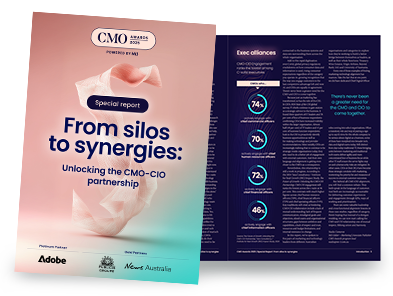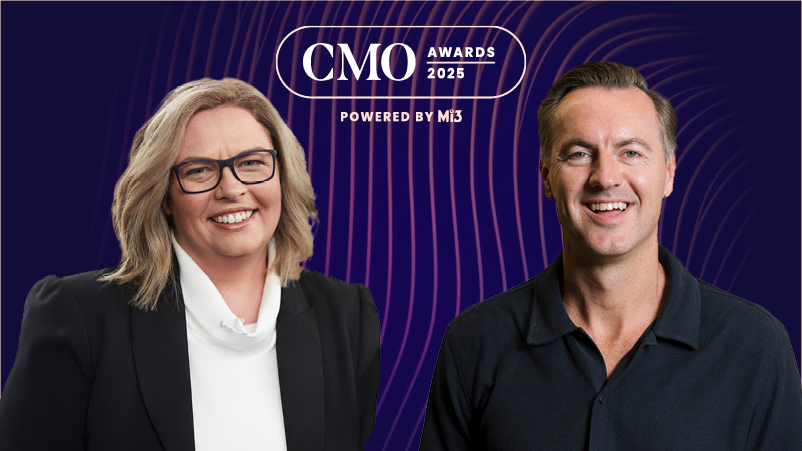Brand is back
Even as the technology and digital progression continues, a counter theme welcomed by judges was the volume of deliberate brand choices and conscious work done by CMOs to prove the value of longer-term brand investment. Judges agreed: There’s a decided recalibration back to brand after years of favouring performance executions and it made its way into many submissions in this year’s CMO Awards.
There were a plethora of references to evidence-based principles of marketing, Byron Sharp and Binet & Field and the need to get closer to optimum brand-to-performance ratios espoused by these industry luminaries. Submissions for example, showed marketing leaders willing to drop or dial back martech utilisation programs, putting focus back on content investment, and executing pilot programs of creative-led brand work to prove its effectiveness.
In other words, CMOs are doing their best to get back to brand over performance, and reacquainting ourselves with the principles of marketing. Judges agreed the fact we’re finally seeing not just belief in brand as a unit of value creation, but demonstrations of it, was fantastic. CMOs are fighting for it and creativity and we know both are essential to true cut-through and engagement.
Ruthless efficiency mentality
More broadly however, it’s clear CMOs are grappling with a relentless need to drive efficiency, productivity through simplification, and better alignment. Some submissions showed marketing teams applying AI tools for this purpose – although instances of AI weren’t anywhere near as common as judges had expected overall. One suggestion is marketers are still in an experimental phase and haven’t yet been able to articulate progression or improvements from early AI use cases. Where a submission did detail a brand harnessing AI for a net new business or customer benefit, it shone.
“What was interesting for me was almost a lack of emergence of AI from a generative search perspective; I was expecting a lot more people to be pushing into this as we're starting to see consumer behaviour pushing towards a new search paradigm. But it only came up twice,” commented Zeederberg.
The heavy emphasis on here-and-now efficiency and improving productivity fed into Batistich’s fourth theme: “I felt like there was more this year than in other years on new ways of working - resetting how we operate, which could include things like automation, or in-house capabilities, which came through quite a bit,” he noted. “To some extent, what we’re talking about here is CMOs noticing the environment is changing faster than their capability.”
One example is in-housing: While historically, this was more a matter of appointing search or social staff member internally, award submissions demonstrated how significant the shift to creative as an in-house job is.
“I appreciated a those who had fewer, bigger, better ways of thinking about things,” continued Leo Australia MD, Clare Pickens. In a nod to the breadth of submissions and types of organisations and remits reflected, she observed some CMOs dealing with huge amounts of complexity, whereas others clearly have simpler decision-making structures.
“There's such a huge focus on efficiency and not always a balance of effectiveness as well. There were lots of examples of how I'm cutting down operations and saving money here, there and everywhere. The next question is: Where are you reinvesting in future value, or what value are you delivering as a result of that?”
People and capability development needs work
The CMO Awards questionnaire also required CMOs to detail how they have been working to build people and team capability and skillsets – vital if they’re to keep up with the transformational changes to marketing, as well as finding both efficiencies and effectiveness.
A number of CMOs talked about proactive marketing competency programs, and several were specifically leveraging work the Australian Marketing Institute (AMI) has done around its Skills and Competency framework.
“We saw a real mix of those who had thought about this and definitely have capability programs and frameworks in play, then a middle group either using AMI or another form of capability approach,” said Bradshaw. A bit further down, some were using Mark Ritson and the MiniMBA. “Then there's the ones doing weekly WIPs and focused on some values and behaviours – the long tail of normal business practices.”
AMI CEO and former FMCG and QSR marketing chief, Bronwyn Heys, was on the hunt for deliberate cultural and capability work across CMO Awards submissions.
“There were a few that stood out who were doing different and interesting things. But a lot didn't mention anything about competency upskilling and it felt a little bit to me like ticking the box on the people question,” she said. “Where there were interesting examples around the culture piece which stood out for me, I thought wow, you're trying and doing something quite different.”
Commercial focus
Where things really come to the crunch with judges is how well marketing leaders can ladder up functional metrics and figures into a commercial impact narrative.
“Some clearly understood the sales drivers across their business, but a few too many were still highlighting vanity metrics like increases in social followers,” commented Baxter.
Bradshaw noted the lack of the ‘profit’ word. “Commercial acumen and lack of marketing profitability, dollar signs, and an overreliance on advertising ROI was prevalent,” he said.
The ability to build a narrative using data is another mark of distinction between good and great marketing chiefs. “For some people, data is just measurement. We’ve been doing that for 10 years, haven't we?” Pickens asked.
“Data as insight is where you're getting to something a little bit juicier. How are you actually using that? How are you building that whole picture of customer? How are you using first-party data to create utility, innovation or communication off the back of that where you wouldn't be able to innovate that product or create that piece of work or messaging without that data?”
Areas of improvement aside, CMO Awards judges agreed the job of marketing leadership is the broadest, most diverse they have ever seen it. With that comes challenges, but it’s also a time of fruitful opportunity for the CMOs who are curious, brave and bold enough to embrace it.



































